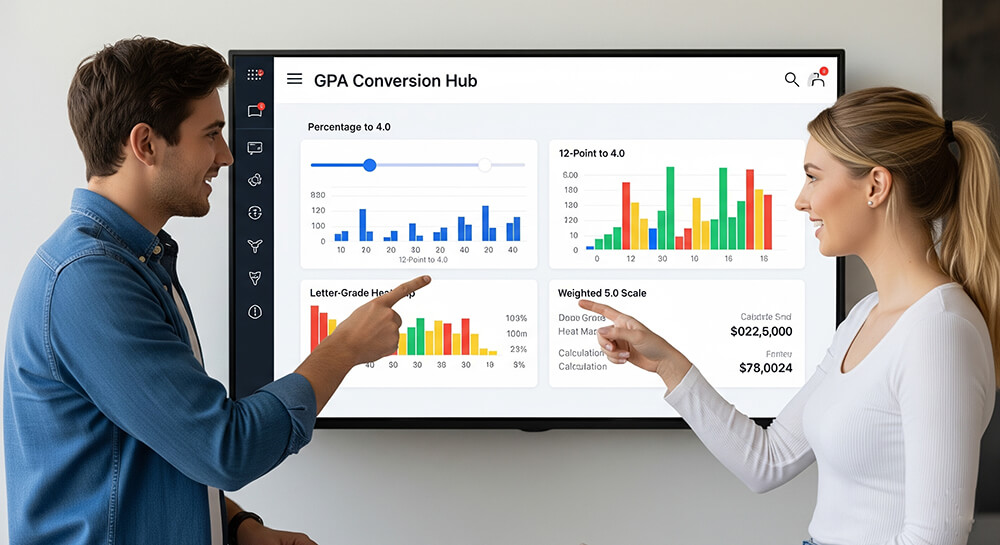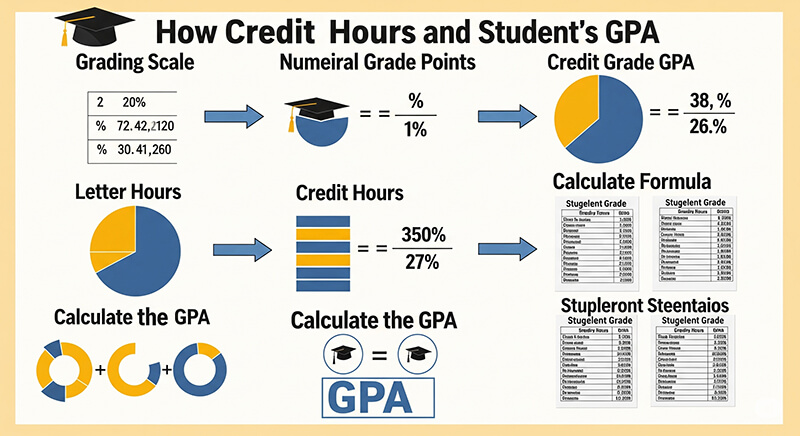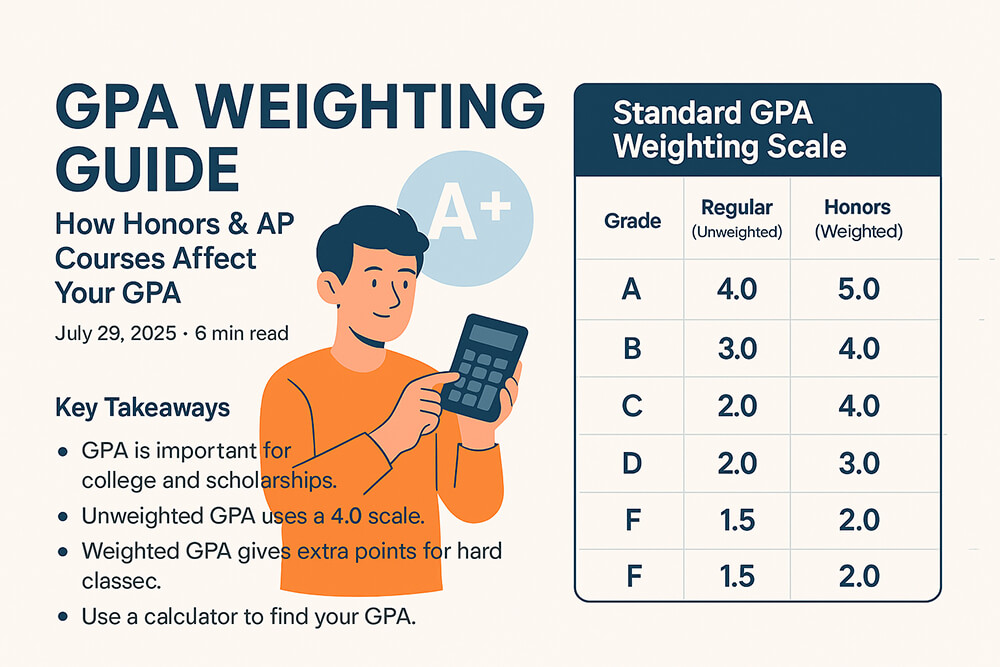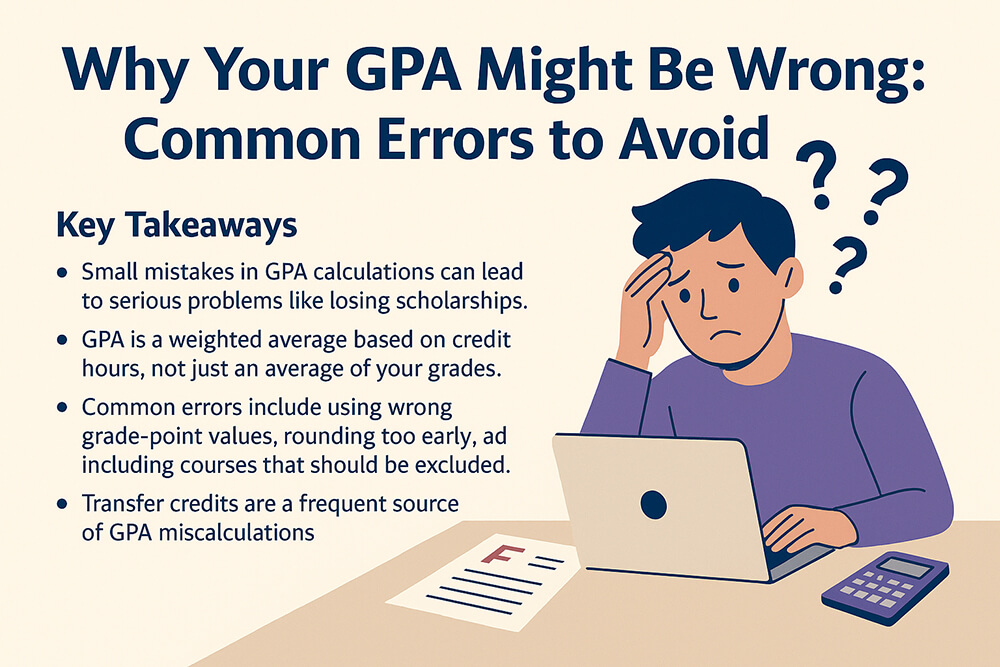Key Takeaways
| Conversion Type | Best For | What It Does |
|---|---|---|
| Percentage to 4.0 | High school and international students. | Converts your percentage grades (e.g., 95%) into a standard 4.0 GPA. |
| 12-Point to 4.0 | Students with grades from Canadian or some IB programs. | Translates a 12-point score into the familiar 4.0 scale used in the U.S. |
| GPA to Percentage | College applicants and academic planners. | Turns your GPA back into a percentage to help you set and track grade goals. |
| 100-Point to 5.0 | Students in AP, IB, or Honors courses. | Calculates your weighted GPA on a 5.0 scale, showing course rigor. |
| Letter-Grade Heat Map | Students, educators, and academic advisors. | Visually shows how grades are distributed in a course to help with class selection. |
Understanding GPA Conversion
Grades come in many forms. You might have a percentage, a letter, or a score on a different scale. A GPA conversion tool helps you translate your grade into a standard format. This is important for college applications, scholarships, and tracking your own academic progress. Each conversion type serves a different purpose, from simple calculations to detailed analysis. To get started, you can learn the basics with a GPA calculator guide.
Percentage-to-4.0 GPA Converter
One of the most common needs is to change a percentage grade into a 4.0 GPA. The 4.0 scale is the standard in most U.S. high schools and colleges. The conversion is straightforward. An 'A', which is often 93% or higher, equals a 4.0. A 'B', around 85%, is a 3.0, and so on. This tool is very helpful for students who are used to percentage grades and need to see their GPA. You can learn more about the math behind this in a GPA formula guide. A detailed percentage to 4.0 GPA conversion chart can give you the exact numbers.
12-Point to 4-Point Scale Chart
Some schools, especially in Canada, use a 12-point grading scale. To apply to schools in the U.S., students need to convert this score to the 4.0 scale. A 12-point to 4-point scale chart makes this process easy. For example, a 12 on the 12-point scale is a perfect 4.0. An 11 is a 3.9, and a 10 is a 3.7. This conversion helps create a standard measure for students from different educational systems. International students can also use a study abroad grades GPA integrator to manage their grades.
GPA to Percent Reverse Calculator
Sometimes you have your GPA and need to know the percentage equivalent. A GPA to percent reverse calculator does this for you. This tool is great for academic planning. If you want to achieve a certain GPA, the calculator will tell you the average percentage you need to earn in your classes. For example, to get a 3.7 GPA, you would need to aim for an average of 92.5%. This helps you set clear goals for each semester. You can use a semester GPA calculator to track your progress.
100-Point to 5-Point Conversion for Weighted Grades
The 5.0 scale is used for weighted GPAs. This system gives you extra credit for taking more difficult classes like Honors, AP, or IB. A 100-point to 5-point conversion helps you calculate this weighted GPA. An 'A' in a regular class is a 4.0, but in an AP class, it becomes a 5.0. This shows colleges that you have challenged yourself academically. Understanding the difference between weighted vs. unweighted GPA is key to presenting your best academic self.
What is a Letter-Grade Heat Map?
A letter-grade heat map is a visual tool that uses color to show how grades are distributed in a course. Bright, "hot" colors show grades that are given out frequently, while cool colors show grades that are less common. This can help students choose courses by showing the typical grade outcomes. It can also reveal trends like grade inflation over time. To understand your own grade trends, you can use a GPA trend graph generator.
The Importance of Course Weighting
Course weighting is the reason some students can have a GPA above 4.0. It rewards them for taking on more rigorous coursework. A GPA weighting guide for Honors and AP explains how this works. Typically, Honors classes add a 0.5 boost, and AP or IB classes add a 1.0 boost. This system is explained in detail in a 5.0 GPA scale guide. It is important to know your school's policy, as it can be a big factor in your class rank.
Why School Policies Matter
Every school district and university has its own set of rules for calculating GPA. A guide on how school districts calculate GPA shows how much these policies can differ. The percentage needed for an 'A' or the amount of weight given to an Honors class can vary. This can lead to GPA inflation vs. deflation, where a 3.8 at one school is not the same as a 3.8 at another. Always check your school's official handbook for the most accurate information.
Tools for High School Students
For students preparing for college, the right tools are essential. A high school GPA calculator is designed to handle different course levels, from regular to AP. It is also a good idea to start planning early. A freshman year GPA predictor can help you set goals from the beginning of your high school career. These tools help you stay on track for college applications.
GPA Calculators for College Students
College students have different needs. A college GPA calculator often includes credit hours in its calculations. To see your overall performance, a cumulative GPA calculator is the best choice. For students on a different academic calendar, a trimester GPA calculator is also available. These tools help you monitor your progress toward graduation and academic honors.
Managing Special Academic Situations
Your academic record might include some unique situations. If you have credits from another institution, a transfer credits GPA integrator can help you combine them. Some courses are graded as pass/fail, and a guide on how pass/fail grades impact your GPA explains how they are handled. If you have an incomplete grade, a GPA planning for incomplete grades resource can help you prepare.
Advanced GPA Analysis
For a deeper look at your academic performance, you can use more advanced tools. If you are considering a new academic path, a major change GPA impact tool can show you how that might affect your GPA. You can also separate your grades by subject with a core vs. elective GPA calculator or a prerequisite-only GPA calculator. These tools provide valuable insights for making informed academic decisions.
Avoiding Common GPA Calculation Errors
When you calculate your GPA, small mistakes can lead to a big difference. It is important to use a guide on common GPA calculation errors to avoid to ensure you get it right. One common mistake is not using your school's exact grading scale. Another is incorrectly calculating weighted grades. Regularly checking your work with a transcript GPA audit guide can help you catch any errors.
Frequently Asked Questions (FAQ)
What is the easiest way to convert my grades to a 4.0 GPA? The easiest way is to use an online percentage-to-4.0 converter. You enter your percentage grade, and the tool gives you the corresponding GPA based on a standard scale.
How do I calculate my weighted GPA? To calculate your weighted GPA, you first need to know your school's policy for weighting Honors and AP/IB courses. Then, you can use a weighted GPA calculator that allows you to specify the type of course for each grade you enter.
Can I have a GPA higher than 4.0? Yes, if your school uses a weighted GPA system. By taking advanced courses like AP or IB and earning high grades, the extra weight can boost your GPA above a 4.0, often up to a 5.0.
Are all GPA conversion charts the same? No. While many schools use a standard conversion chart, the exact percentage ranges for letter grades and the amount of weight given to advanced courses can vary by institution. It is always best to check your school's specific policies.
What is the difference between a 4.0 and a 5.0 scale? A 4.0 scale is typically unweighted, meaning an 'A' is always worth 4.0 points, regardless of the course's difficulty. A 5.0 scale is weighted, meaning an 'A' in a challenging AP or IB course can be worth 5.0 points, rewarding students for taking on more rigorous classes.













